How To Make an Affordable DIY Winter Boat Cover
A DIY winter boat cover is an affordable way to protect your boat during the winter months. Not only can it save you money compared to purchasing a pre-made cover, but it also allows you to customize the cover to fit your specific boat. In this article, we'll walk you through the process of making an affordable boat cover, from choosing the right materials to measuring and cutting the cover to fit your boat.
First, choose the right fabric, but before starting, you need to measure your boat to ensure a perfect fit. Once you have your pattern, you can build the boat cover frame and start sewing your boat cover. Once sewn, it's time to secure it to the frame.
While a DIY winter boat cover saves you money, you'll need to have the right materials on hand to get started. Below, you'll find a long list of the materials you'll need for this project.
Summary
- A dark-colored fabric such as navy blue, black, or dark green is better for colder climates as it absorbs heat and keeps the interior warmer.
- Measuring your boat is necessary so that the cover should fit snugly, cover all areas properly, and account for any curves or angles.
- If the cover is prone to wear and tear in certain areas, adding patches to those areas is the best way to add durability.
- When making a winter cover for a sailboat with a mast, you will need to cover it separately with a tarp or foam pipe insulation to prevent damage from the weight of the snow or ice.

On this page:
The steps below will help you create a custom boat cover that fits your boat perfectly and keeps it safe from the elements:
Choose The Right Fabric For Your Winter Boat Cover
You might want a fabric that is durable, waterproof, and UV-resistant. Look for fabrics that are specifically designed for outdoor use and can withstand harsh weather conditions.
Factors to consider when choosing the right fabric
Here are some factors to consider when choosing fabric for the cover:
- Material: The material of the fabric should be strong and durable enough to withstand harsh winter weather conditions. Some common materials used for winter boat covers include polyester, canvas, and vinyl-coated fabrics.
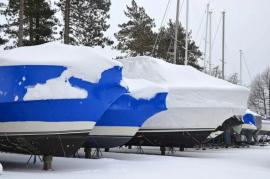
What's the Best Material for Winter Boat Covers?
-
Water resistance: The fabric should be water-resistant or waterproof to prevent water from seeping through and damaging the boat. A fabric with a high level of water resistance will also prevent mold and mildew growth.
-
UV protection: The fabric should provide UV protection to prevent fading and damage from the sun's harmful rays.
-
Breathability: The fabric should be breathable to prevent moisture buildup and ensure proper ventilation.
-
Weight: The weight of the fabric should be appropriate for the size of the boat. A heavier fabric may be necessary for larger boats to provide adequate protection.
-
Color: The color of the fabric can affect the temperature inside the cover. A lighter color will reflect sunlight and keep the interior cooler, while a darker color will absorb heat and keep the interior warmer.
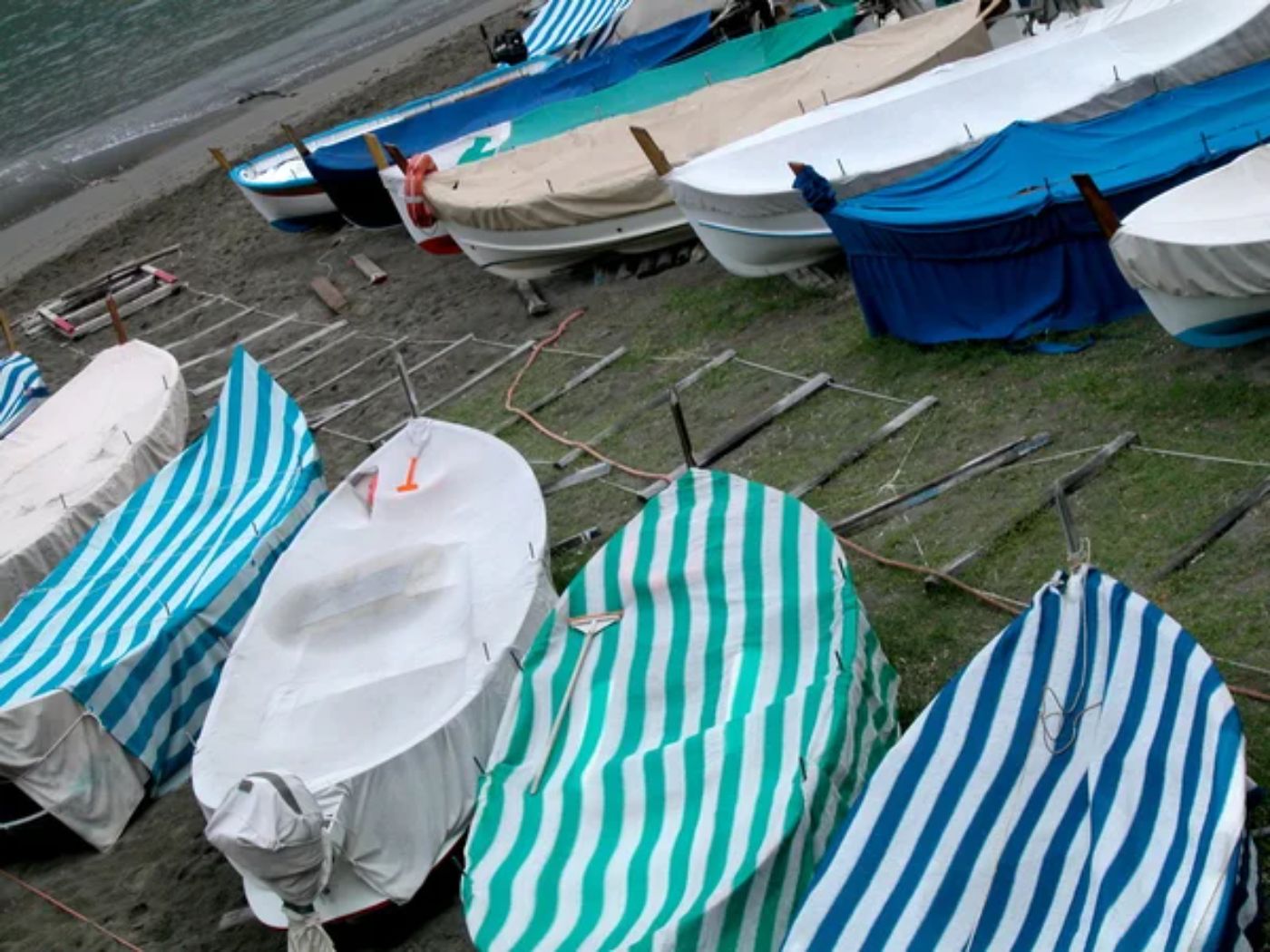
Types of fabric for winter boat covers
The table below shows a complete comparison of the different types of fabric used for winter boat covers:
| Type of Fabric | Description | Pros | Cons |
|---|---|---|---|
| Polyester | Lightweight, durable, and water-resistant | Easy to clean and maintain | May not provide as much protection as other fabrics |
| Canvas | Heavy-duty fabric that provides excellent protection against the elements | Water-resistant, breathable, and provides good UV protection | More expensive than other fabrics |
| Vinyl-coated fabrics | Highly water-resistant and provides excellent protection against UV rays | Easy to clean and maintain | Heavy and may not be as breathable as other fabrics |
Measure Your Boat For A Perfect Fit
Before you start building your boat cover, you may need to measure your boat to ensure a perfect fit. The cover should fit snugly around the boat to provide adequate protection.
Tips for measuring your boat accurately
-
Use a tape measure: Use a flexible tape measure to measure the length, width, and height of your boat. Make sure the tape measure is long enough to reach all areas of the boat.
-
Measure from the highest point: When measuring the height of the boat, measure from the highest point to the ground. This will ensure that the cover fits over any antennas, lights, or other protruding objects.
-
Account for accessories: If your boat has any accessories that will be covered by the winter boat cover, such as a swim platform or trolling motor, make sure to measure them as well.
-
Check the measurements: Once you have measured the length, width, and height of your boat, double-check the measurements to ensure accuracy.
-
Add extra inches: Add a few extra inches to the measurements to account for any curves or angles on the boat. This will ensure that the cover fits snugly around the boat.
-
Test the fit: Once you have made the necessary adjustments, test the fit of the cover on the boat. Make sure it fits snugly around the boat and covers all areas properly.
Build The Boat Cover Frame

Once you have your pattern, it's time to build the boat cover frame. Here's how to do it:
-
Measure the length, width, and height of your boat to determine the size of the frame you will need.
-
Purchase PVC pipes or electrical conduits in the appropriate lengths and thicknesses to create your frame. Consider using thicker pipes for larger boats or boats in areas with high winds.
-
Use a saw or pipe cutter to cut the pipes to the appropriate lengths. You may need to make angled cuts to accommodate the shape of your boat.
-
Assemble the frame using connectors. You can use T-shaped connectors to create a crossbar, or elbow-shaped connectors to create angled corners.
-
Make sure the frame is tall enough to accommodate any protrusions on your boat, such as antennas or masts.
-
Test the stability of the frame by gently pushing on it from different angles. Make any necessary adjustments to ensure it is secure.
If you plan to make a DIY boat cover frame, here are three affordable ways to make one.
Sew The Boat cover
Once you have your frame in place, it's time to sew your boat cover. Use your pattern to cut out the fabric, leaving a few inches of extra material around the edges. Here are some techniques for cutting and sewing the fabric:
-
Cut the fabric: Use the measurements you took to cut the fabric for the winter boat cover. Use a sharp pair of scissors or a rotary cutter to ensure clean cuts.
-
Sew the panels together: Sew the panels together using a sewing machine or by hand. Use a heavy-duty thread and a strong stitch to ensure durability.
-
Reinforce the seams: Reinforce the seams by sewing a second row of stitches or by adding seam tape. This will prevent the seams from tearing and ensure that the cover lasts longer.
Add Reinforcements And Straps For Durability
Adding reinforcements and straps will increase the durability of the cover and ensure that it stays in place during harsh winter weather conditions.
Techniques to add durability to the cover
The table below shows some types of reinforcements to add to the cover:
| Technique | Description |
|---|---|
| Patches | Heavy-duty fabric sewn onto areas prone to wear and tear for added durability. |
| Double-stitch | Second row of stitches parallel to the first row to reinforce seams for added strength. |
| Seam tape | Waterproof tape applied to seams to prevent water from seeping through. |
| Grommets | Metal rings inserted into the fabric to create tie-down points for ropes or bungee cords. |
Secure The Boat Cover
When your cover is sewn and reinforced, and your frame is ready, it's time to secure the boat cover by following these steps:
- Lay the cover over the boat, making sure it is centered and covers the entire boat.
- Attach one end of a bungee cord to the cover and the other end to the frame. Repeat this process for all four corners of the cover.
- Use additional bungee cords or rope to tie down any areas of the cover that are loose or flapping in the wind. Make sure the cover is snug and secure, but not so tight that it puts undue stress on the frame or the cover itself.
- If your boat has any protrusions, such as antennas or masts, make sure the cover is secured around them to prevent them from tearing the cover.
- Consider adding additional tie-downs, such as straps or buckles, to keep the cover from shifting or blowing away in high winds.
- Test the cover by gently pulling on it from different angles to make sure it is secure. Make any necessary adjustments to ensure it is properly secured.
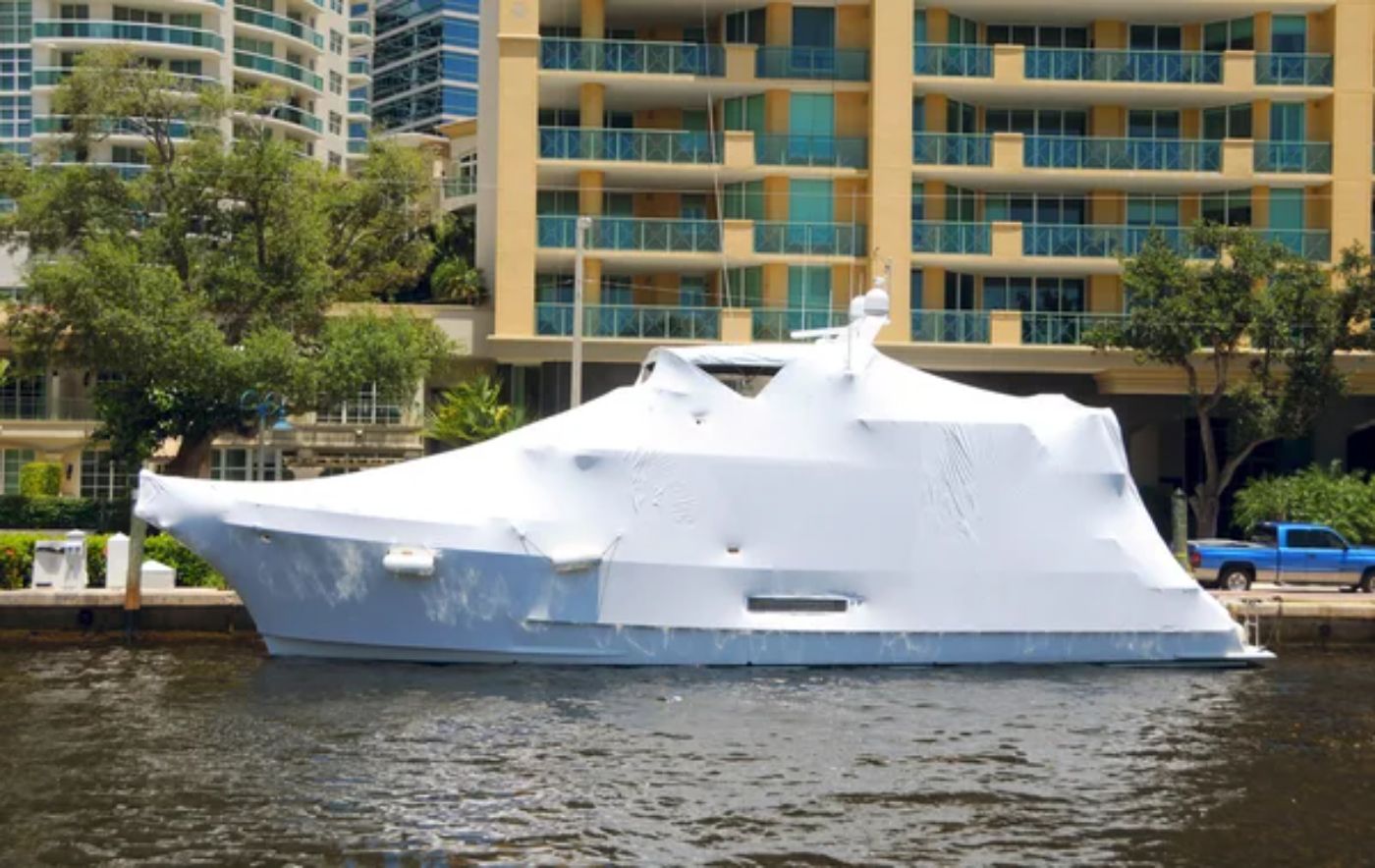
Maintain Your Boat Cover
To keep your affordable DIY winter boat cover in good condition, you'll need to maintain it properly. Clean it regularly with mild soap and water, and store it in a dry, cool place when not in use.
If you notice any tears or damage, make repairs promptly to prevent further damage. Fold the cover properly to prevent creases and wrinkles.
Ideally, you may also want to consider using a cover support system to prevent water from pooling on the cover. This will prevent damage to the cover and ensure that it lasts longer.
To learn more about the pros and cons of a winter boat cover, you might want to read this article.
Materials Needed For A DIY Boat Cover
Below is a list of the materials you'll need to make an affordable DIY boat cover:
You'll need a canvas cover material
Sunbrella is a popular choice because it's durable, water-resistant, and resistant to fading from the sun. You can also choose from a variety of colors to match your boat's aesthetic.
You'll need PVC pipe to create a boat cover frame
You can purchase PVC pipes at your local hardware store. However, you need to measure your boat carefully before purchasing the pipe, so you know how much you'll need.
You'll need grommets to attach the cover to the frame
You can purchase grommets at your local hardware store. Be sure to choose a size that fits the diameter of your PVC pipe.
List of tools to make a cheap DIY boat cover
Here's a list of tools you'll need to make a DIY boat cover:
- Hacksaw
- Screwdriver
- Scissors
- Sewing machine
Other optional materials
Here are a few optional materials you may want to consider:
- Bungee cords to secure the cover to the boat
- Adhesive velcro strips to keep the cover in place
- Rope or cordage to tie down the cover
Making A Sailboat Winter Cover
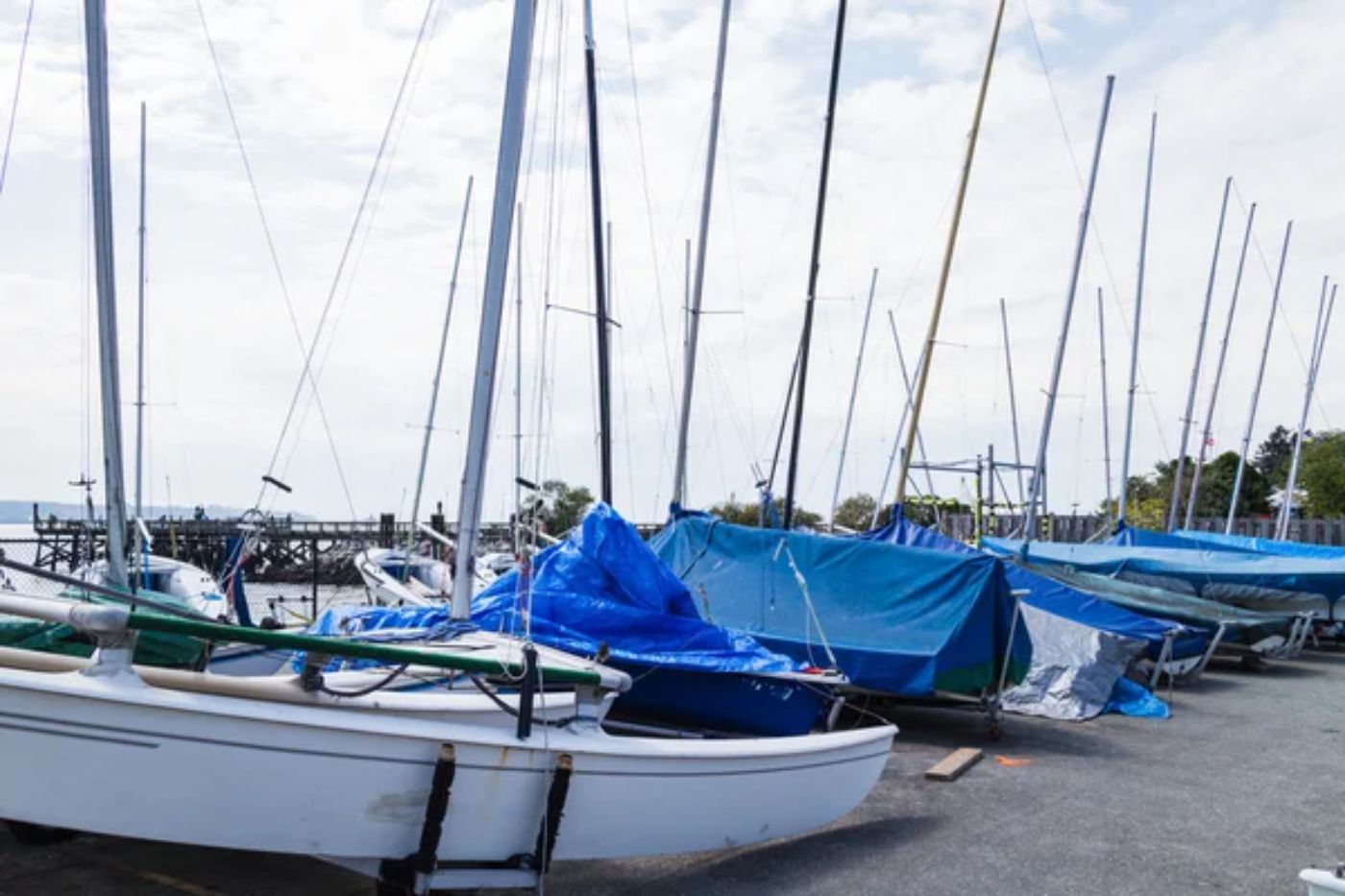
When it comes to making a sailboat winter cover, the design of the cover needs to take into account the unique features of the sailboat, such as the mast, rigging, and sails. The cover needs to be designed to fit snugly around these features and provide complete protection from the elements.

How to Winterize Your Sailboat Cheaper & Quicker
How to do DIY sailboat winter cover
The process of making a DIY winter cover for a boat is similar to making a cover for a sailboat, but there are a few key differences to keep in mind:
Sailboats require a different cover shape
Sailboats typically have a more streamlined shape, with a flat deck and a tall mast, while boats can have a variety of shapes and sizes, with different features such as a windshield, cabin, and other protruding features.
When making a winter cover for a boat, you need to take into account the shape of the boat and any protruding features, such as the windshield or antennas. This may require creating a custom shape for the cover to ensure a snug fit and optimal protection.
Sailboats require a smaller cover
Sailboats are usually on the smaller end, so less materials are required. Therefore, you'll also need fewer reinforcement straps or grommets to the cover to ensure it stays in place and doesn't sag or tear under the weight of snow or ice.
How to tarp a sailboat for winter
If you don't have the time or resources to make a DIY winter cover, you can use a tarp to protect your sailboat from the winter weather. Here are the steps you can follow to tarp your sailboat:
Measure your sailboat
Start by measuring the length, width, and height of your sailboat. These measurements will help you determine the size of the tarp you need.
Choose your tarp
You can use a variety of tarps for your sailboat, such as polyethylene or canvas. Check if the tarp is waterproof and can withstand harsh winter weather.
Cut the tarp
Use your measurements to cut the tarp to the appropriate size. You may need to cut several pieces of tarp to cover the entire boat.
Secure the tarp
Use bungee cords or ropes to secure the tarp to the boat. Make sure the tarp is tight and there are no gaps or flapping in the wind.
Add support
To prevent water from pooling on the tarp, you can add support poles or PVC pipes under the tarp. This will also help prevent damage to the boat from the weight of the snow or ice.
Cover the mast
If your sailboat has a mast, you will need to cover it separately with a tarp or foam pipe insulation. This will help prevent damage to the mast from the weight of the snow or ice.
Check the tarp regularly
Throughout the winter months, check the tarp regularly to make sure it is still secure and there are no tears or holes. If you notice any damage, repair it immediately to prevent further damage to the boat.

3 Creative Boat Prop Cover Ideas for Winter
Did you find the answer to your specific question?
👍 0 👎 0


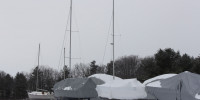
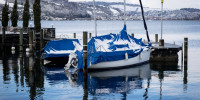
Leave a comment